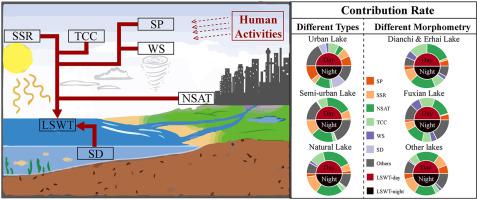Water Research ( IF 12.8 ) Pub Date : 2020-06-23 , DOI: 10.1016/j.watres.2020.116018 Kun Yang 1 , Zhenyu Yu 2 , Yi Luo 1

|
Lake surface water temperature (LSWT) is an important factor in lake ecological environments. It has been observed that LSWT have followed an upward trend in the last half century, which has had serious impacts on regional biodiversity and climate. It is important to understand the main reason for this phenomenon in order to have a basis for controlling and improving the regional ecological environment. In this study, the contribution rates of near surface air temperature (NSAT), surface pressure (SP), surface solar radiation (SSR), total cloud cover (TCC), wind speed (WS) and Secchi depth (SD) to LSWT of 11 naturally formed lakes in the Yunnan-Guizhou Plateau are quantified. The characteristics of and relationships between the various factors and LSWT in lakes of different types and attributes are revealed. The results show that: (1) from 2001 to 2018, most lakes were warming; the change rate of LSWT-day was higher than that of LSWT-night. The mean comprehensive warming rate (MCWR) of LSWT-day was 0.42 °C/decade, and the mean comprehensive change rate (MCCR) was 0.31 °C/decade; the MCWR of LSWT-night was 0.19 °C/decade, and the MCCR was 0.01 °C/decade. NSAT and SSR were most strongly correlated with LSWT-day/night. There were no large seasonal differences in the correlation between NSAT and LSWT-day, while seasonal differences in the correlations between NSAT with LSWT-night and SSR with LSWT-day/night were observed. (2) NSAT and SSR were the most important factors affecting LSWT-day/night changes, with contribution rates of 30.24% and 44.34%, respectively. LSWT-day was more affected by SP and SSR in small, shallow, and low-storage lakes. For larger lakes, LSWT-day was more affected by WS, while LSWT-night was greatly affected by TCC. Urban and semi-urban lakes were more affected by SSR and NSAT; for natural lakes, the decreasing SD affected the increases in LSWT, which indirectly reflects the impact of human activities. LSWT-day/night responded differently to different morphological characteristics of the lakes and different intensities of human activity.
中文翻译:

云南贵州高原主要湖泊湖面水温驱动因素分析。
湖泊地表水温度(LSWT)是湖泊生态环境中的重要因素。据观察,近半个世纪以来,小规模野生动植物的生长呈上升趋势,这对区域生物多样性和气候产生了严重影响。重要的是要了解这种现象的主要原因,以便为控制和改善区域生态环境奠定基础。在这项研究中,近地表气温(NSAT),地表压力(SP),地表太阳辐射(SSR),总云量(TCC),风速(WS)和塞奇深度(SD)对LSWT的贡献率对云贵高原11个自然形成的湖泊进行了量化。揭示了不同类型和属性的湖泊中各因子与低水WT的特征及其之间的关系。结果表明:(1)从2001年到2018年,大多数湖泊都在变暖; LSWT-day的变化率高于LSWT-night。LSWT-day的平均综合升温速率(MCWR)为0.42°C /十年,平均综合变化速率(MCCR)为0.31°C /十年;LSWT-night的MCWR为0.19°C /十年,而MCCR为0.01°C /十年。NSAT和SSR与LSWT日/夜关系最密切。NSAT与LSWT-day之间的相关性没有明显的季节性差异,而NSAT与LSWT-night之间的关系和SSR与LSWT-day / night之间的相关性却没有季节差异。(2)NSAT和SSR是影响LSWT日夜变化的最重要因素,贡献率分别为30.24%和44.34%。在小,浅和低储量湖泊中,LSWT-day受SP和SSR的影响更大。对于较大的湖泊,WS白天对LSWT的影响更大,而TCC对LSWT-night的影响更大。SSR和NSAT对城市和半城市湖泊的影响更大。对于天然湖泊,SD的降低影响了LSWT的增加,这间接反映了人类活动的影响。白天/夜晚的LSWT对湖泊不同形态特征和不同人类活动强度的反应不同。



























 京公网安备 11010802027423号
京公网安备 11010802027423号